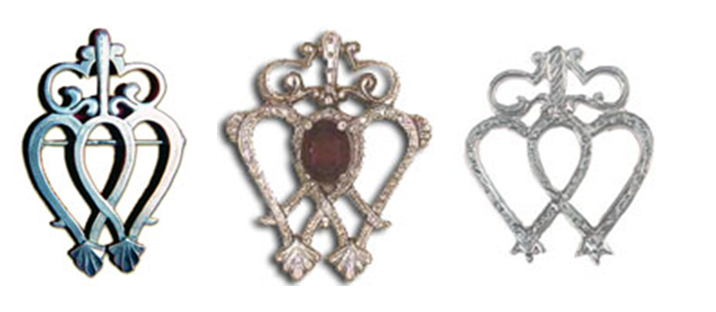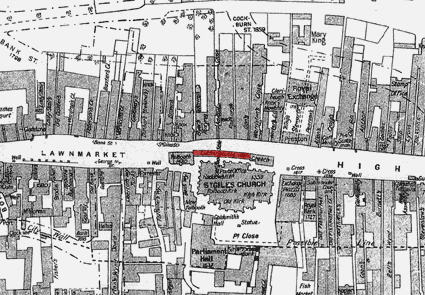| This Week’s Topic… | |

Best viewed in
|
The Luckenbooth Brooch
During the sixteenth to eighteenth centuries there were two main styles of brooches in Scotland; one was the ring brooch, often with incised decoration, and used to fasten plaids by both men and women. The other brooch was a heart shaped one, often given at weddings and engagements as tokens of love. From the eighteenth century onwards small plain heart shaped brooches were worn to protect against evil spirits, the evil eye or the attention of the fairies. These are the famous “Luckenbooth Brooches”. These brooches were heart shaped ones surmounted by a crown and usually made of silver. Their names come from “The Luckenbooth or Locking Booths”. These small shops, which were in fact very tiny and could be securely locked at night, were a feature of Edinburgh’s Royal Mile.
Built around 1460, the Luckenbooths or "Locked booths" housed Edinburgh's first permanent shops. The row of seven tenement buildings is connected to the Old Tolbooth, running parallel to St Giles. Originally exclusive to the use of goldsmiths and jewelers, they later housed tenants with a variety of trades including a baker, milliner, hairdresser and "ane chymist and druggist".
Between the south wall of this building block and the wall of the
Churchyard is a narrow close called the Krames, where retailers without
premises began to offer their wares around 1550-60. Lord Cockburn
described this area as "The paradise of childhood' on account of the
toys, trinkets and other hardware sold at stalls along this pathway. The first Luckenbooth brooches date from the late XVII century and were very small. This traditional gift was given to a man’s sweetheart on their betrothal but also it was considered a lucky charm, protecting the wearer against evil eyes. Among other powers the Luckenbooth has, was easing the pain at childbirth and ensuring a good flow of breast milk when pinned to a woman’s petticoats near the left thigh. If pinned to the baby’s shawl, it will protect the child from being stolen by fairies. During the XVIII and XIX centuries the Luckenbooth became larger and more elaborate with inscriptions on the back such as biblical references or the initials of the couple and the date of their betrothal. Another legend of the luckenbooth is that it was a symbol of love and devotion, which Mary Queen of Scots is said to have given to Lord Darnley. It has the St. Andrew Cross, the Scottish thistles, and entwined hearts. From 1850 onwards, the intertwined hearts resembling the letter “M” came to be called Mary’s Brooches or even Queen Mary’s Brooches. Most Luckenbooth brooches today are in the form of two hearts topped by a crown and are made of silver, though versions of this traditional Scottish brooch can be found in iron and brass. Victorian ones were generally set with garnets. Garnets were thought to have a lucky influence on affairs of the heart and symbolized a lover’s constancy as well as being an emblem of deep friendship. The Victorian versions of the Luckenbooth brooch were decorated with gems of different colors. |

